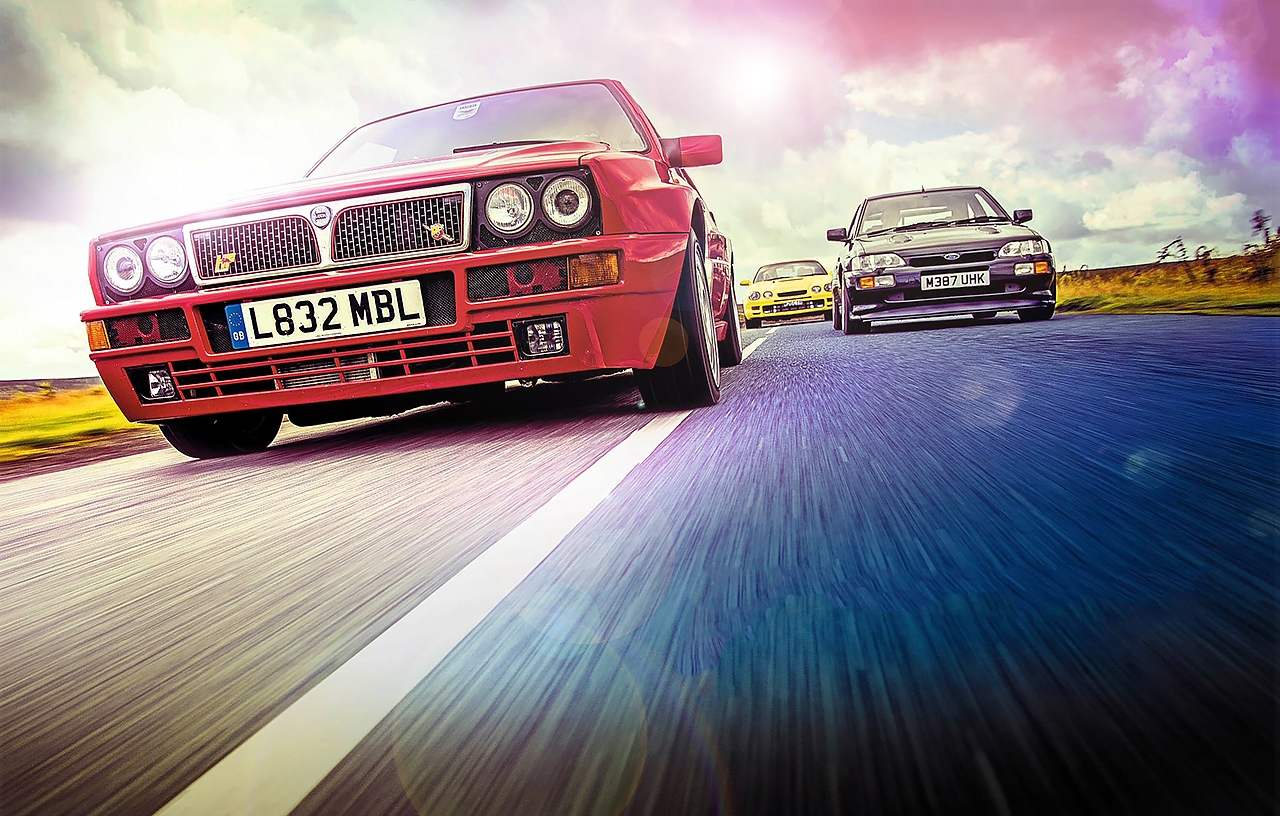
A for Effort. Group – a face – off. Integrale still the top dog? The Ford RS and Toyota GT-4 don’t think so. Rallying’s greatest road cars came from Group A. Thirty years on from its beginnings, we compare three of the best drivers’ choices. Unleash the racers. Integrale: Can the legend fend off its modern classic rivals? 30 years after the end of Group B, we bring together the best cars the Group A rallying era spawned to find out which one hits hardest. Words Richard Bremner. Photography Jonathan Jacob.
Even though it had nothing to do with them, you can thank the Volkswagen Group for these cars.
It was Ferdinand Piëch, one-time boss of Audi, who had the idea for the Quattro, the four-wheel drive, turbocharged five-cylinder coupé that won the brand the World Rally Championship in 1982, and vaulted Audi decisively higher up the ‘want one’ list Suddenly, 4WD was what you needed for rally victories, and what car enthusiasts – just as suddenly – decided they wanted. Carmakers around the world scurried to build their versions of the Quattro. Audi’s super-coupé was followed by a stream of imitators, some brilliant, others forgotten. Mazda 323 turbo 4×4, anyone?
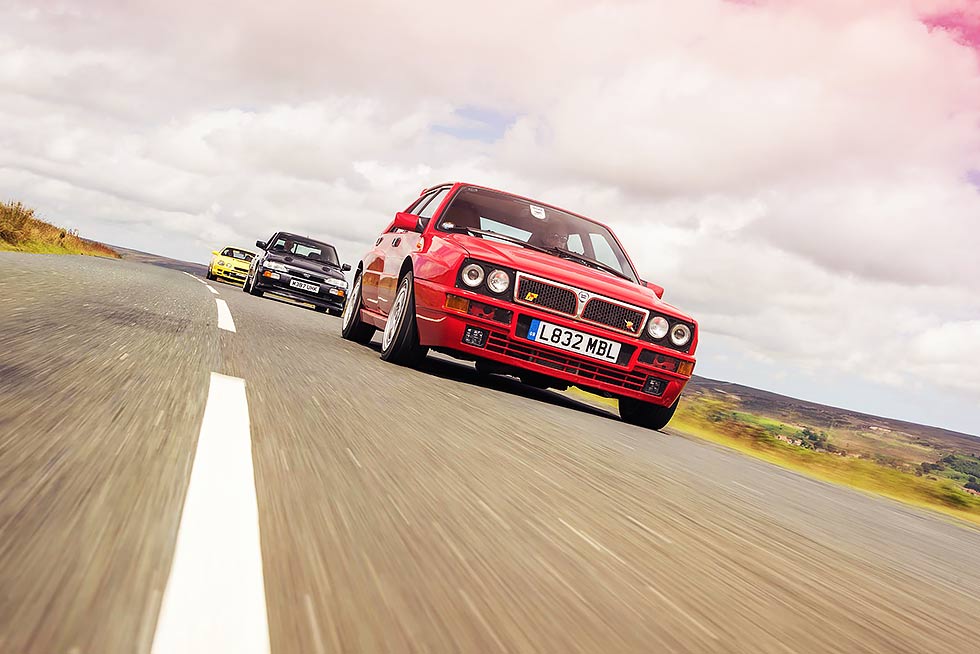
The three cars here are in the brilliant category. All were built for forest, gravel, tarmac and trophies, and all made great road cars. And two of them would be virtually driven by millions, the Lancia Delta Integrale and the Toyota Celica GT-4 skating the screens of Sega Rally machines the world over. The third member of our trio – the Ford Escort Cosworth – started life as another car. All three have confronted one another in rallying and collected ample silverware in the process. Now they must contend with another factor – the passage of time. How do these three stack up 20 years on?
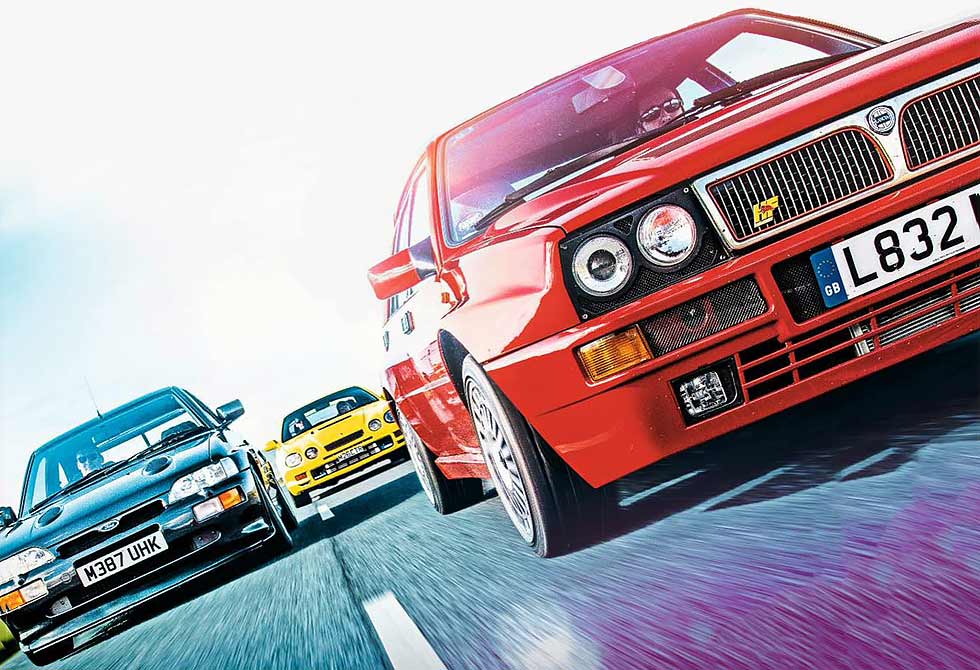
Ford Escort RS Cosworth
Red Bull doesn’t give you wings – Ford does. Oh and 227bhp to play with, too.
This is a mad car, and we’re not talking about that preposterous rear wing. The madness is to be found in its engineering, the steroidal flared arches, vented bonnet and not terribly subtle aerodynamic sproutings masking the mechanicals of the bigger Ford Sapphire RS Cosworth. Which means that unlike every other Escort of this generation, the engine is in-line rather than transverse and the gearbox lies behind it. Shrinking and reskinning a car is no small task, the design and engineering carried out by Ford’s famous Boreham facility, the complicated assembly entrusted to German coachbuilder Karmann.
The giant rear wing may have provided the police with reasons to apprehend, but with the Ford’s front splitter and a lesser tailgate spoiler, this Escort actually generated positive downforce.
Escort Cosworths come in several varieties. The first 2500 homologation models were fitted with a larger Garrett T3/T40B turbocharger; from late 94 a smaller, lag-reducing Garrett T25was used. A few early cars were Motorsport versions shorn of the Lux’s sunroof, sound deadening, electric windows, Recaros and heated screen. A limited edition Monte Carlo version celebrated victory in this rally, while a light facelift came in 1995.
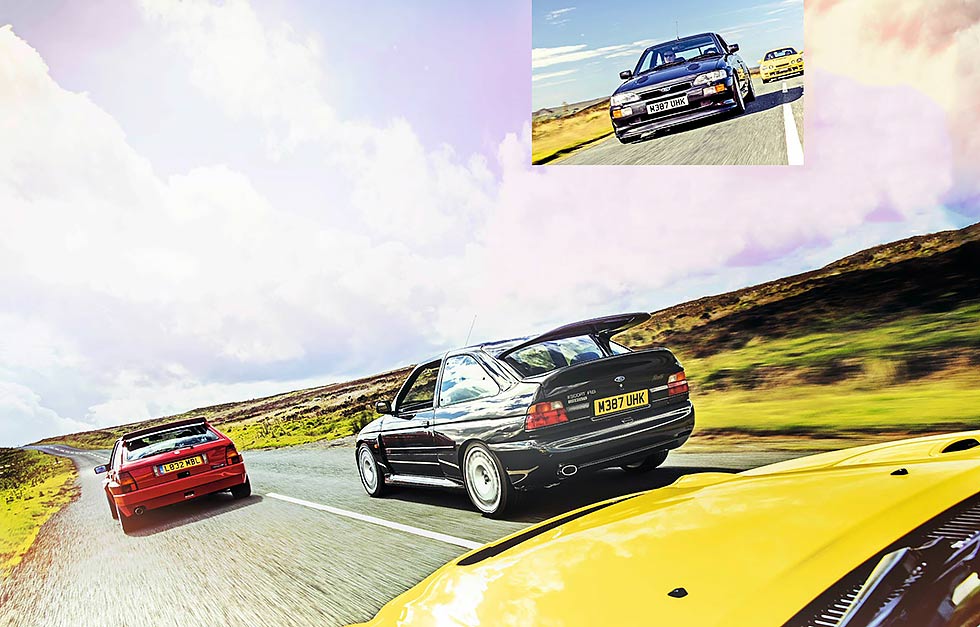
All you need is Tony Mason and Propaganda: Jewelled, really. Even the police had to get Cossies to keep up with the nicked ones.
But in whatever form it comes, the result is a pleasingly compact, lightly muscular machine stirring 227bhp and 200lb ft of torque, fed in 34:66 per cent portions to the front and rear axles. A viscous coupling prevents driveline wind-up, and the back wheels can rely on an LSD for some controlling extra thrust. And so can you if you try hard enough – this Cosworth is capable of spearing bends rough or smooth at improbable speeds.
Although it certainly doesn’t feel that way at first. This engine felt rampant in the Sierra Cosworth in which it first appeared, but aboard this heavier Escort it feels curiously lethargic, on top of which you can still hear the engine’s trademark vibratory drone. The gearchange appears to be lubricated with mozzarella, and the driving position is more budgie on its perch than snake in the grass. Not a good start, and this car feels suspiciously soft in the damping department, too. All of which makes it easy to see why plenty of owners explore the scope for tuning.
But like its lag-dampened performance, you must be patient with the Cosworth to uncover its best. Patient, and committed to extracting more from it if you want to understand why it’s one of the medium bright stars in Ford’s RS firmament. Stoke some momentum with gearbox and accelerator, tackle a long, flowing, twisting B-road and you begin to see how this car won the Monte Carlo rally. It’s supple, grippy and decently pointable, especially if you plunge the accelerator deep to make the best of its viscous diff’s torque apportionment skills. This particular car feels slightly tired in the damper department and less poised than it might be, but nose it into a bend with zeal and the Ford warms to the task. It’s satisfyingly effective, even if you have to work at it.
I BOUGHT ONE
‘I’d always wanted an Escort Cosworth since I saw a red one when it was new,’ says James Ingram. ‘I’ve had mine three years, and specifically sought out a Monte Carlo edition, as it’s a bit special. The parts situation can be a bit expensive – the lower splitter and “hockey stick” mouldings are unavailable too. It’s never really broken down, however.’
NEED TO KNOW ESCORT RS COSWORTH
Many Cosworths are tuned, boost increases more easily achieved with the early big turbo motor. If it’s been modified, be sure to find out how– more boost requires uprated injectors, for example. The MT75 gearbox will take 375bhp, the viscous coupling 330bhp, the clutch 300bhp.
Check for clicking universal joints, tired dampers and bushes and cracked top-mount cups, which will knock. The bigger turbo can be unreliable – check for blue smoke on start-up – and head gasket failure is common. The low-grade fuse box can be troublesome.
The Cosworth’s bodywork is bespoke to the model and expensive to repair. Checking for accident damage is vital. Rust is rarely an issue – if present, poor accident repair is the likely cause. Check the battery tray for corrosion, the lower rear wing for bubbling, the front splitter for damage and the nose for stone-chips. A good service history is vital, as are quality tyres, cambelt changes and the correct plugs and ignition leads.
SPECIFICATIONS Ford Escort RS Cosworth
Engine 1993cc/4-cyl/DOHC
Power 227bhp @ 6250rpm
Torque 224lb ft @ 3500rpm
Maximum speed 153mph
0-60mph 6.2sec
Fuel consumption 28-33mpg
Transmission 4WD, five-speed man
How many left? 357
WHAT TO PAY?
Concours £50,000
Good £25,000
Usable £15,000
Project £12,000
Lancia Delta Integrale Evo 2
Point it at the horizon and attack – the little Lancia makes everyone Juha Kankkunen
From the moment you fire it up, this Lancia feels ready to play. Its engine fizzes keenly and the slightly odd driving position, which has you high up and slightly hunched over the wheel, provides a promisingly clear view out.
This car feels like it wants to get down the road, and you’re very swiftly doing exactly that, the revs climbing exponentially as the turbo puffs up. When you get to a bend the Delta darts at it, not too fast but with enough verve to have you speeding harder towards the next. It feels more agile than its elegantly blocky styling and four doors might suggest, and comfortably supple with it.
Going harder is no effort, and you soon find the Integrale has the grip and stability to underwrite its enthusiasm. The 16-valve here is two solid iterations into Lancia’s development of the 4WD Delta, and nearing the peak of its still-impressive capabilities. The path to the ultimate delta Evolution began with the HF Turbo 4wd that arrived in 1985.Modestly styled, it made little impact despite its 164bhp 2.0-litre turbo motor, a big output for the day. Adding power, widening its track and swelling its fenders with a fulsome set of boxy flares did the trick, turning Lancia’s modestly classy hatchback into a winner of rally stages and comparison tests.
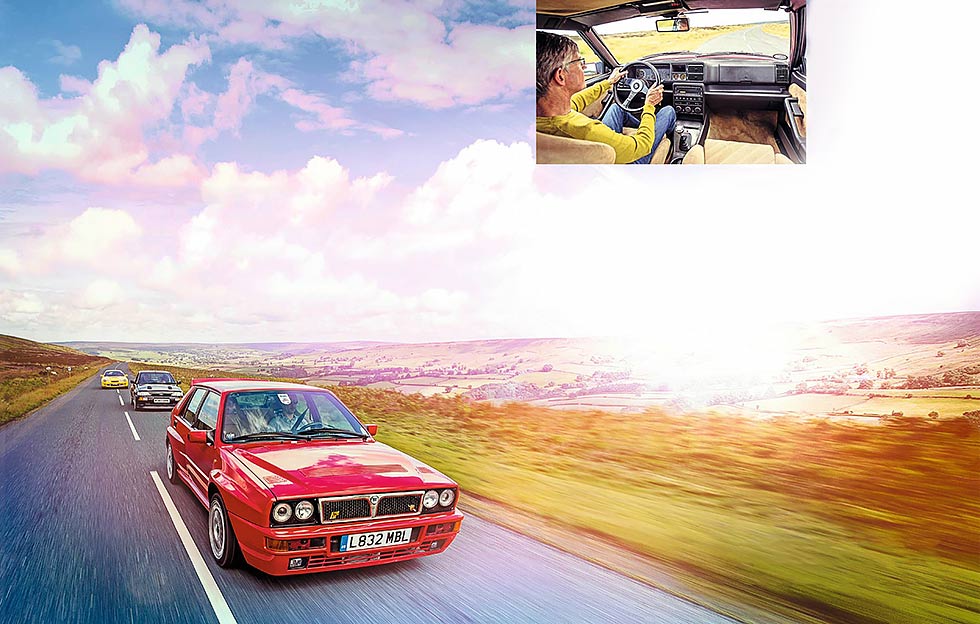
Odd seating arrangement, but Richard’s having too much fun to care.
The 8-valve’s revised 2.0 litre featured new valves, a bigger turbocharger and extra cooling to develop 185bhp. It also had balancer shafts to produce manners more suitable for a Lancia, and an exciting extra name – Integrale. Soon the car bearing this badge was demonstrating the benefits of these technologies to resounding effect on rallies, collecting more silverware than the Delta’s modest boot could carry. The wins and the development continued, 1991’s 207bhp 16-valve Integrale impressing not only with its extra power and revised 47:53 front/rear torque split, but a promise packed bonnet bulge to accommodate all those fast-pumping valves.
It’s one of these that we enjoy here. And enjoy is the word, the Delta’s impressively neutral handling, cleanly precise steering, surging go and absorbent suspension willing you to explore more.
You’ll turn up more bodyroll, a brake pedal that travels too far and a gearchange that feels like you’re wrestling a small sapling. Though not in this improved car, which has upgraded brakes, and a quickshift gearchange. And just as it is always did, the Delta’s interior creaks like a galleon in a swell, its spindly column stalks look likely to snap and you stare at undersized – but stylish – instruments. Despite all these drawbacks the interior is an attractive environment, lifted by plentiful Alcantara upholstery and surprisingly comfortable seats. What strikes you as much as the flaws is the Delta’s eagerness and, when you get it on the right road, its ferociously capacity for gobbling miles. It’s no longer the fastest A-to-B machine it was in its prime, but it’s still fast, fun and a pleasure to look at.
‘You soon find the Integrale has the grip and stability to underwrite its enthusiasm’
I BOUGHT ONE
‘It was my childhood sweetheart car,’ says Wayne Meneely. ‘I used to go to rallies and they were winning at the time. If you don’t look after them and don’t drive them often, that’s when they’re a problem. Parts can be expensive and hard to find. This one blew its cylinder head – that was a £3k bill.’
NEED TO KNOW LANCIA DELTA INTEGRALE
You need evidence of cambelt changes: the 16V needs renewal every 24k miles. A low oil level puts main bearing number three in jeopardy – check the level, and that the oil is golden. Turbos are good for 80k miles, but must be replaced, even if functioning – blade wear reduces their effectiveness.
Clutches should make 60,000 miles. Strong, pliant bushes are vital to the Delta’s balletic potential. Rear trailing arm bushes are often shot at 30k miles, the front rubbers are fading at 40-50k miles and the anti-roll bar drop-links of the Evolution need renewal at 20k miles. Corrosion protection is fairly good, but windscreen surrounds, door and tailgate bottoms, sills, rear arches and the sunroof aperture are potential decay areas.
Check for accident damage – body repair isn’t cheap. Check for consistent panel gaps, paint mis-matches, damage to inner panels such as the boot floor. Even minor body damage will cost. Delta interiors creaked even when new, but shouldn’t be hugely worse if the car has been cared for. Seat bolster wear is common, and the pale Alcantara will showstains. Check all the electrics, as well as the heating and ventilation.
SPECIFICATIONS Lancia Delta Integrale Evo 2
Engine 1995cc/V6/DOHC
Power 207bhp @ 6250rpm
Torque 220lb ft @ 3500rpm
Maximum speed 153mph
0-60mph 6.0sec
Fuel consumption 25-30mpg
Transmission 4WD, five-speed man
How many left? 141
WHAT TO PAY?
Concours £60,000
Good £40,000
Usable £30,000
Project £18,000
Toyota Celica GT-Four ST205
There’s nothing mellow about this yellow devil – and it’s a fraction of the cost of a Delta
The first thing to surprise you about the Celica GT-Four is not that bold loop of a wing but its interior, whose surfaces are an unrelenting medley of blacks, some slightly shiny, some matt, some fabric and all cheap. The surprise is that Toyota could get away with such starkly unappealing interiors. But it did, customers drawn by its bulletproof reliability and in the case of this Celica, performance and handling to mimic the rally version that Toyota was campaigning to considerable effect.
This was an expensive car in its day, costing almost £30,000 when an Escort Cosworth was £5000 less. So they were rare even when new. The ST205 version you see here is the third in a series of road going rally cars that debuted with the 1986-1989 fourth-gen Celica ST165 and saw the most success with the ST185, this model winning three WRC championships during its 1989-1993 life. The 1993-1999 ST205 was less successful, but did win the European Rally Championship in 1996.
The GT-Four package includes an engine that in standard form produces a fat 239bhp, Toyota’s so-called super strut multi-link front suspension; brakes from the Supra; and a high-rising spoiler at the rear. To this the limited edition WRC version added water injection, an anti-lag device, revised engine management and an altered exhaust manifold. The car you see here isn’t one of those, but it has been modified to generate plenty of extra power – the engine is good for 360bhp without major mods – and a snuffling wastegate that sounds like an industrial-strength central heating system.

If you didn’t see the Celica coming, you’d certainly hear it.
Soundtrack apart, the result is a car that feels quite similar to the Delta. The Celica has that same willingness to change direction, the same pliant, almost loping ride and the same need for the engine to build a head of steam – which is exactly what it sounds like in this modded car – before it really gets going. And yes, it really does go, and without the accompaniment of rattles generated by the Lancia. Its precise steering, unhesitating turn-in and excellent stability make you go harder. It stops well too, and as with the Delta you can perform satisfying trimmings of your trajectory with throttle as well as wheel. The engine note isn’t as invigorating as the Delta’s, but you’ll rarely hear it beneath the huffings and puffings of this modified car.
But it certainly delivers the goods. A shame, then, that you don’t sit in a more stylish environment, but be in no doubt – it’s a mighty effective crosscountry car, even by today’s standards.
I BOUGHT ONE
‘It’s Japanese, 4wd and turbo, so it ticks all the boxes,’ says Andy Weightman. ‘It’s easy to find parts, but they are expensive. It’s pretty good on reliability and fuel. This one’s been highly modded, but I want a standalone ECU so I can write custom fuel maps. I don’t have the heart to sell it.’
NEED TO KNOW TOYOTA CELICA GT-FOUR
Like all these cars, this Celica needs plenty of care, including regular oil and filter changes at 4500 miles, new platinum plugs at 27k, a coolant change at 36k, and a fresh cambelt at 60k.
The super strut system features a figure-of-8 joint that’s wear-prone; it’s best to replace the lower arms too. The engine is tunable to over 360bhp with no internal mods. The chargecooler fluid level must not be allowed to drop. Cracked radiators, blown head gaskets, smokey turbos, rumbling wheel bearings, worn clutches are all possibilities. Clunks on lift-off from the rear are a worn differential mount.
Front bumpers can lose paint. Sills rust where they joint with the front wing. Imports are common, so has the speedo been changed to mph, and what measurement is the odometer using? A damp carpet up front may be because of a leaking heater matrix.
‘Its precise steering, unhesitating turn-in and excellent stability make you go harder’
SPECIFICATIONS Toyota Celica GT-Four ST 205
Engine 1998cc/4-cyl/DOHC
Power 239bhp @ 6000rpm
Torque 223b ft @ 4000rpm
Maximum speed 152mph
0-60mph 6.3sec
Fuel consumption 28-34mpg
Transmission 4WD, five-speed man
How many left? 574
WHAT TO PAY?
Concours £10,000
Good £7000
Usable £5000
Project £2000
THE FINER POINTS
All three were designed to defeat all on the world rally stage, and as such they’re stacked full of elements there solely to give these cars the cutting edge.
Anyone for Paisley? Recaro seats scream 1990s leisure centre cafe, but they keep you firmly in place for hard cornering. Tightly packed There’s not much room under the Delta’s bonnet, but the compact dimensions help to make the car just so much fun. Breathed upon? Just a bit, sir Front-mounted intercooler, hybrid turbo, dump valve, boost controller, fuel pressure regulator – and a lot more besides. Don’t mess with this Celica. Pipe dreams Not one of Toyota’s but it helps accentuate the meaty roar the tuned engine churns out. Not discreet but we don’t really care… Dialling it in No-nonsense interior is brought to lifeby an instrument binnacle that looks like a 1970s synthesiser. Alcantara- trimmed chairs feel fantastic – they’re expensive to fix, however. Top shelf. Even more shocking than the Sierra? Terrible for rear visibility, great for pinning the Ford to the road – and as a handy beverage tray. Functional. There’s not much to relish in the Toyota, but the aftermarket Momo steering wheel reminds us of Sega Rally. Blown cover. The Monte Carlo edition was a run-out special for the big turbo versions of the Escort Cosworth. Loveably laggy, endlessly tuneable. Work of art Okay, so the bumper doesn’t match the upper panel, but the Lancia’s wheels are great to look at.
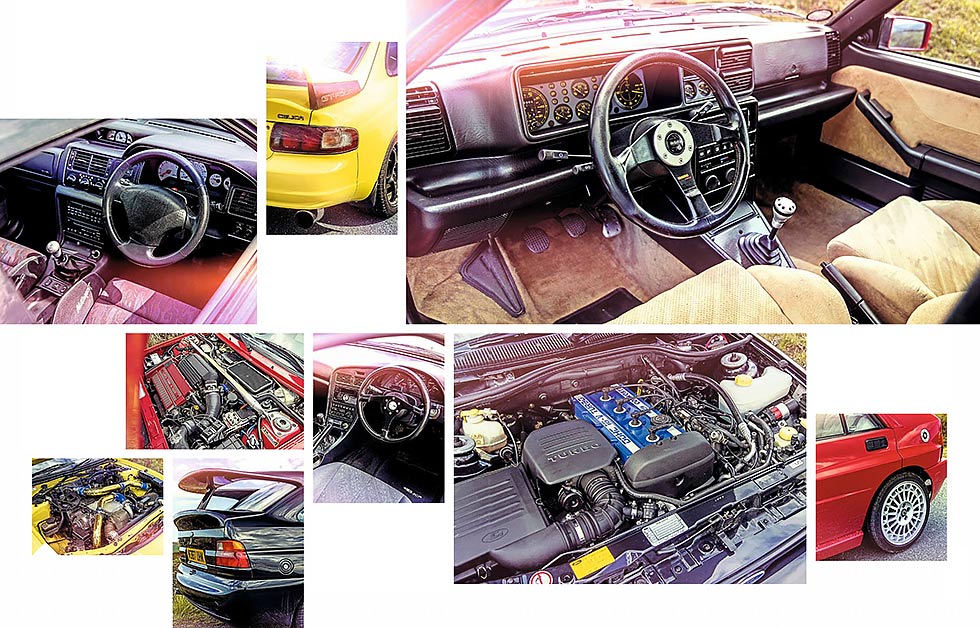
Which one’s the finest Modern Classic? Turn the page to find out…
Verdict / The Modern Classics view
It’s no surprise that a quarter of a century later, all three of these cars feel dated. But the bigger – and better – surprise is that dynamically they can still compete, mustering terrific grip, balance and agility, and the power to put it to use.
Better still, they predate electric power steering systems and super-firm suspension, enabling them to tackle battered ‘B’ roads as if they were pothole free, and to provide real feedback when changing direction. That was the point of these cars then, and it remains the most satisfying point of them now.
First to go, nonetheless, is the Ford. It’s not instantly willing enough, making it less of an entertainer than the other two. But if you enjoy modding cars, it’s relatively easy to liven it up. The Toyota and Lancia are more evenly matched, both being terrifically able and huge fun. But the Toyota doesn’t feel as special as the Lancia, being undermined by its coalhole cabin and Furniture World seat fabrics. The Delta may have more foibles, but it’s the most desirable, the best looking and the most special to sit in. That said, you can pick up a Celica for a third of the money of a Delta, or less.
Thanks: RS Owners’ Club (rsownersclub. co.uk) Walkers Garage (walkers-garage.co. uk) and Lancia Enthusiasts UK
‘They can still compete, mustering terrific grip, balance and agility, and the power to put it to use’
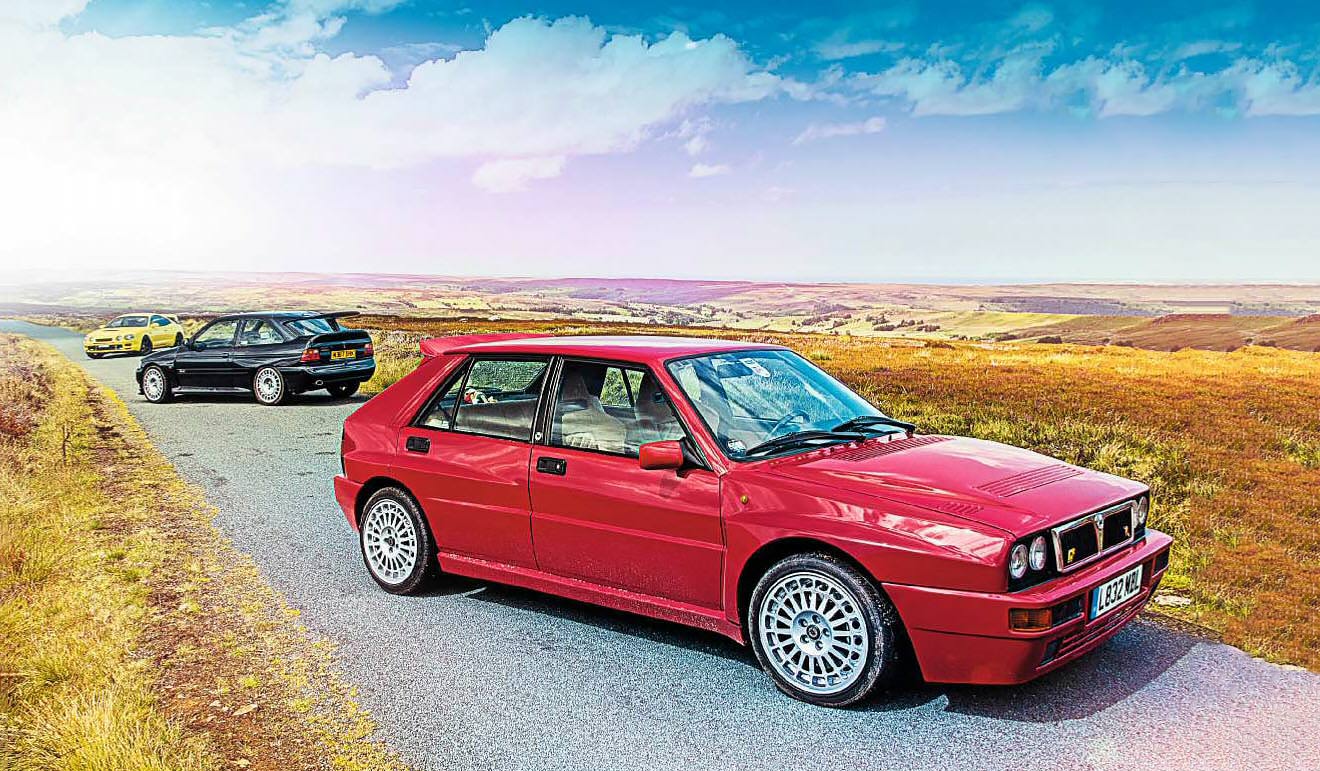
Second opinion
It’s interesting that Richard’s taken the heart-over-head decision of backing the Lancia. I’d counter this with a couple of points – many Lancia parts are becoming cripplingly expensive to buy now (I recently saw an Evo parcel shelf advertised for £900!), and although specialist support is peerless, this is a car that often feels too fragile, too expensive to fix, which makes enjoying a Sunday morning thrash hard. It’s expensive to buy, too, although without doubt, a fairly good investment for the future.
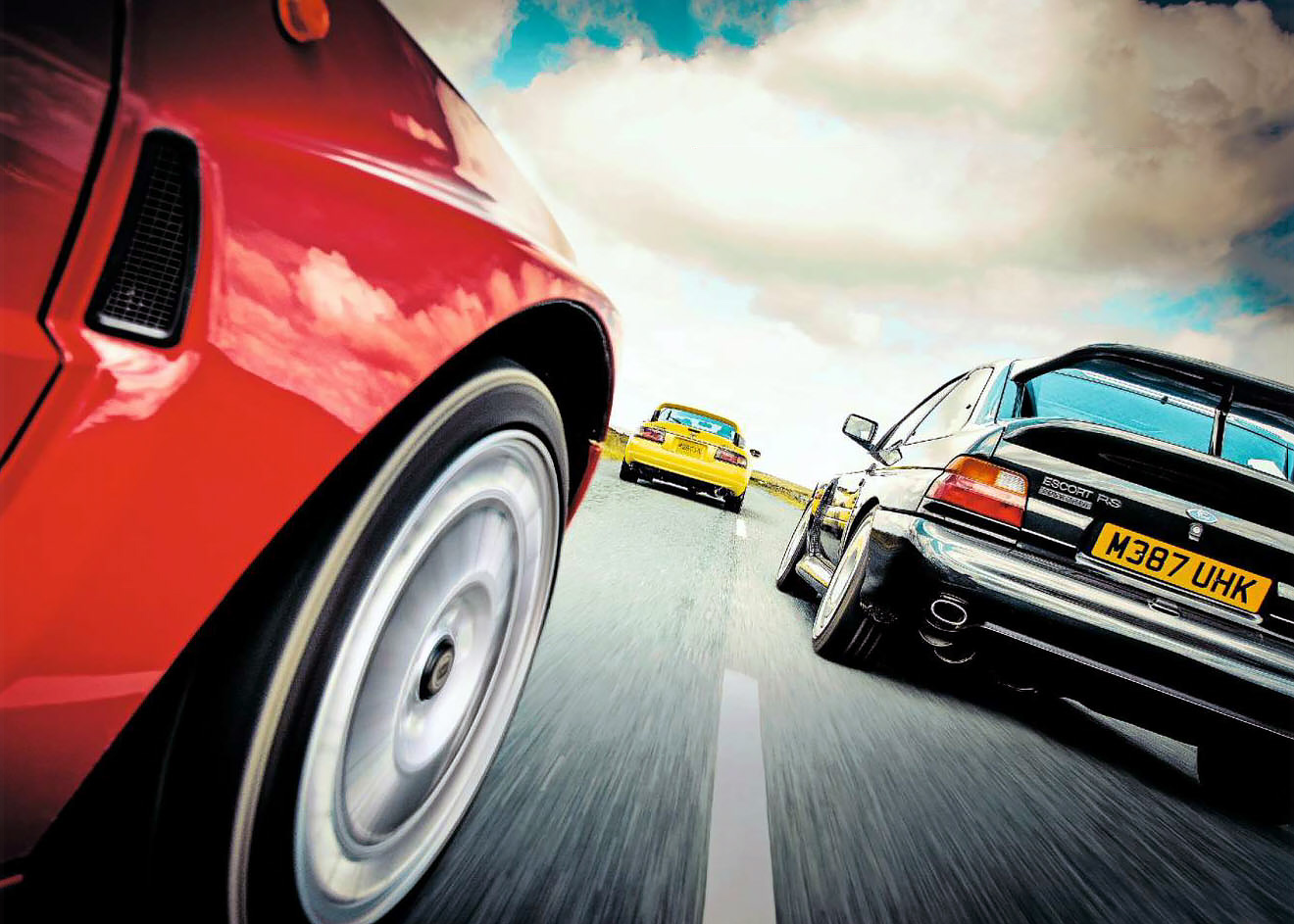
The same things could be said about the Escort, too, although it lacks the Lancia’s access-all-areas kudos that marks that car out as an absolute classic. No, I’d say that the Celica currently stands as the most brilliant Modern Classic of the three, by dint of its price and accessibility – and massive ruggedness. It’s not particularly reliable, though, and don’t let anyone tell you that it is. It also doesn’t have the motor sport winning kudos of the other two. But the GT-Four is a steal at today’s prices – so grab one now, and enjoy. Keith Adams
The Delta takes the crown – it’s flawed, but fantastic. Agree? Tell us.
{CONTENTPOLL [“id”: 75]}





